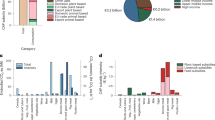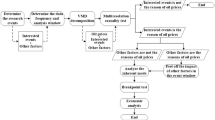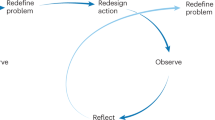Abstract
Scenarios showing future greenhouse gas emissions are needed to estimate climate impacts and the mitigation efforts required for climate stabilization. Recently, the Shared Socioeconomic Pathways (SSPs) have been introduced to describe alternative social, economic and technical narratives, spanning a wide range of plausible futures in terms of challenges to mitigation and adaptation1. Thus far the key drivers of the uncertainty in emissions projections have not been robustly disentangled. Here we assess the sensitivities of future CO2 emissions to key drivers characterizing the SSPs. We use six state-of-the-art integrated assessment models with different structural characteristics, and study the impact of five families of parameters, related to population, income, energy efficiency, fossil fuel availability, and low-carbon energy technology development. A recently developed sensitivity analysis algorithm2 allows us to parsimoniously compute both the direct and interaction effects of each of these drivers on cumulative emissions. The study reveals that the SSP assumptions about energy intensity and economic growth are the most important determinants of future CO2 emissions from energy combustion, both with and without a climate policy. Interaction terms between parameters are shown to be important determinants of the total sensitivities.
This is a preview of subscription content, access via your institution
Access options
Access Nature and 54 other Nature Portfolio journals
Get Nature+, our best-value online-access subscription
$29.99 / 30 days
cancel any time
Subscribe to this journal
Receive 12 print issues and online access
$209.00 per year
only $17.42 per issue
Buy this article
- Purchase on Springer Link
- Instant access to full article PDF
Prices may be subject to local taxes which are calculated during checkout


Similar content being viewed by others
References
Riahi, K. et al. The shared socioeconomic pathways and their energy, land use, and greenhouse gas emissions implications: an overview. Glob. Environ. Change http://dx.doi.org/10.1016/j.gloenvcha.2016.05.009 (2016).
Borgonovo, E. Sensitivity analysis with finite changes: an application to modified EOQ models. Eur. J. Oper. Res. 200, 127–138 (2010).
Stern, D. I., Pezzey, J. C. V. & Lambie, N. R. Where in the world is it cheapest to cut carbon emissions? Aust. J. Agric. Resour. Econ. 56, 315–331 (2012).
Blanford, G. J., Rose, S. K. & Tavoni, M. Baseline projections of energy and emissions in Asia. Energy Econ. 34 (suppl. 3), S284–S292 (2012).
IPCC Climate Change 2014: Mitigation of Climate Change (ed. Edenhofer, O.) (Cambridge Univ. Press, 2014).
IPCC Special Report on Emissions Scenarios (eds Nakićenović, N. & Swart, R.) (Cambridge Univ. Press, 2000).
Moss, R. H. et al. The next generation of scenarios for climate change research and assessment. Nature 463, 747–756 (2010).
van Vuuren, D. P. et al. A new scenario framework for climate change research: scenario matrix architecture. Climatic Change 122, 373–386 (2013).
O’Neill, B. C. et al. A new scenario framework for climate change research: the concept of shared socioeconomic pathways. Climatic Change 122, 387–400 (2013).
Kriegler, E. et al. A new scenario framework for climate change research: the concept of shared climate policy assumptions. Climatic Change 122, 401–414 (2014).
O’Neill, B. C. et al. The roads ahead: narratives for shared socioeconomic pathways describing world futures in the 21st century. Glob. Environ. Change http://dx.doi.org/10.1016/j.gloenvcha.2015.01.004 (2015).
Nordhaus, W. D. A Question of Balance: Economic Modeling of Global Warming (Yale Univ. Press, 2008).
van Vuuren, D. P., de Vries, B., Beusen, A. & Heuberger, P. S. C. Conditional probabilistic estimates of 21st century greenhouse gas emissions based on the storylines of the IPCC-SRES scenarios. Glob. Environ. Change 18, 635–654 (2008).
Kriegler, E. et al. Will economic growth and fossil fuel scarcity help or hinder climate stabilization? Climatic Change 136, 7–22 (2016).
Gillingham, K. et al. Modeling Uncertainty in Climate Change: A Multi-Model Comparison Tech. Rep. (National Bureau of Economic Research, 2015); http://www.nber.org/papers/w21637
Anderson, B., Borgonovo, E., Galeotti, M. & Roson, R. Uncertainty in climate change modeling: can global sensitivity analysis be of help? Risk Anal. 34, 271–293 (2014).
Butler, M. P., Reed, P. M., Fisher-Vanden, K., Keller, K. & Wagener, T. Identifying parametric controls and dependencies in integrated assessment models using global sensitivity analysis. Environ. Model. Software 59, 10–29 (2014).
Bosetti, V. et al. Sensitivity to energy technology costs: a multi-model comparison analysis. Energy Policy 80, 244–263 (2015).
van Vuuren, D. P. et al. Energy, land-use and greenhouse gas emissions trajectories under a green growth paradigm. Glob. Environ. Change http://dx.doi.org/10.1016/j.gloenvcha.2016.05.008 (2016).
Fricko, O. et al. The marker quantification of the Shared Socioeconomic Pathway 2: a middle-of-the-road scenario for the 21st century. Glob. Environ. Change http://dx.doi.org/10.1016/j.gloenvcha.2016.06.004 (2016).
Fujimori, S. et al. SSP3: AIM implementation of shared socioeconomic pathways. Glob. Environ. Change http://dx.doi.org/10.1016/j.gloenvcha.2016.06.009 (2016).
Matthews, H. D., Gillett, N. P., Stott, P. A. & Zickfeld, K. The proportionality of global warming to cumulative carbon emissions. Nature 459, 829–832 (2009).
Allen, M. R. et al. Warming caused by cumulative carbon emissions towards the trillionth tonne. Nature 458, 1163–1166 (2009).
Capros, P. et al. GEM-E3 model documentation JRC Scientific and Policy Reports 26034 (Publications Office of the European Union, 2013); ftp://s-jrcsvqpx102p.jrc.es/pub/EURdoc/EURdoc/JRC83177.pdf
Stehfest, E. et al. Integrated Assessment of Global Environmental Change with IMAGE 3.0. Model Description and Policy Applications (PBL Netherlands Environmental Assessment Agency, 2014).
Waisman, H., Guivarch, C., Grazi, F. & Hourcade, J. C. The Imaclim-R model: infrastructures, technical inertia and the costs of low carbon futures under imperfect foresight. Climatic Change 114, 101–120 (2012).
Anandarajah, G., Pye, S., Usher, W., Kesicki, F. & Mcglade, C. TIAM-UCL Global Model Documentation (UK Energy Research Centre, 2011); http://discovery.ucl.ac.uk/1413198
Emmerling, J. et al. The WITCH 2016 Model-Documentation and Implementation of the Shared Socioeconomic Pathways Nota di Lavoro 42.2016 (Fondazione Eni Enrico Mattei, 2016); http://papers.ssrn.com/sol3/papers.cfm?abstract_id=2800970
IPCC Climate Change 2014: Mitigation of Climate Change (eds Edenhofer, O. et al.) (Cambridge Univ. Press, 2015).
Kriegler, E. et al. Diagnostic indicators for integrated assessment models of climate policy. Technol. Forecast. Soc. Change 90, 45–61 (2015).
Lempert, R. Blindside: How to Anticipate Forcing Events and Wild Cards in Global Politics (Brookings Institution Press, 2007).
Drouet, L., Bosetti, V. & Tavoni, M. Selection of climate policies under the uncertainties in the Fifth Assessment Report of the IPCC. Nat. Clim. Change 5, 937–940 (2015).
Wilson, C., Grubler, A., Gallagher, K. S. & Nemet, G. F. Marginalization of end-use technologies in energy innovation for climate protection. Nat. Clim. Change 2, 780–788 (2012).
Bauer, N. et al. Shared socio-economic pathways of the energy sector—quantifying the narratives. Glob. Environ. Change http://dx.doi.org/10.1016/j.gloenvcha.2016.07.006 (2016).
KC, S. & Lutz, W. The human core of the shared socioeconomic pathways: population scenarios by age, sex and level of education for all countries to 2100. Glob. Environ. Change http://dx.doi.org/10.1016/j.gloenvcha.2014.06.004 (2014).
Dellink, R., Chateau, J., Lanzi, E. & Magné, B. Long-term economic growth projections in the Shared Socioeconomic Pathways. Glob. Environ. Change http://dx.doi.org/10.1016/j.gloenvcha.2015.06.004 (2015).
Ang, B. LMDI decomposition approach: a guide for implementation. Energy Policy 86, 233–238 (2015).
Borgonovo, E. A methodology for determining interactions in probabilistic safety assessment models by varying one parameter at a time. Risk Anal. 30, 385–399 (2010).
Krey, V. et al. Message-globiom 1.0 documentation Tech. Rep. (International Institute for Applied Systems Analysis, 2016); http://data.ene.iiasa.ac.at/message-globiom
Acknowledgements
The research leading to these results has received funding from the European Union’s Seventh Framework Programme [FP7/2007-2013] under grant agreement no. 30832 (ADVANCE). V.B. gratefully acknowledges funding from the European Research Council under the European Community’s Programme ‘Ideas’—Call identifier: ERC-2013-StG/ERC grant agreement no 336703—project RISICO ‘RISk and uncertainty in developing and Implementing Climate change pOlicies’. G.M. and M.T. gratefully acknowledge funding from the European Research Council under the European Community’s Programme ‘Ideas’—Call identifier: ERC-2013-StG/ERC—project COBHAM ‘The role of consumer behaviour and heterogeneity in the integrated assessment of energy and climate policies’.
Author information
Authors and Affiliations
Contributions
G.M., M.T., V.B. and E.Ó. designed the experiment. All authors contributed to the final design, implemented the scenarios and provided model output data. G.M. performed the sensitivity computations. G.M. and M.T. wrote the first draft of the paper. All authors contributed to the final writing of the paper.
Corresponding author
Ethics declarations
Competing interests
The authors declare no competing financial interests.
Supplementary information
Supplementary Information
Supplementary Information (PDF 892 kb)
Supplementary Information
Supplementary Information (XLSX 401 kb)
Rights and permissions
About this article
Cite this article
Marangoni, G., Tavoni, M., Bosetti, V. et al. Sensitivity of projected long-term CO2 emissions across the Shared Socioeconomic Pathways. Nature Clim Change 7, 113–117 (2017). https://doi.org/10.1038/nclimate3199
Received:
Accepted:
Published:
Issue Date:
DOI: https://doi.org/10.1038/nclimate3199
This article is cited by
-
Systematic review of the uncertainty of coral reef futures under climate change
Nature Communications (2024)
-
A multimodel analysis of post-Glasgow climate targets and feasibility challenges
Nature Climate Change (2023)
-
Implications of intercontinental renewable electricity trade for energy systems and emissions
Nature Energy (2022)
-
Using large ensembles of climate change mitigation scenarios for robust insights
Nature Climate Change (2022)
-
Land-based climate change mitigation measures can affect agricultural markets and food security
Nature Food (2022)



